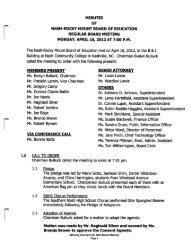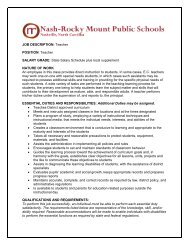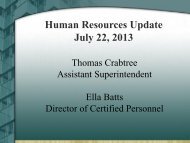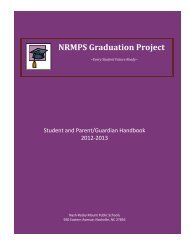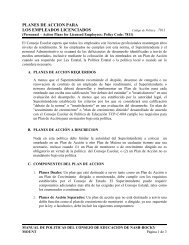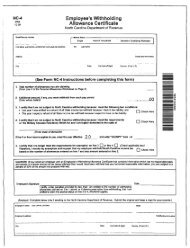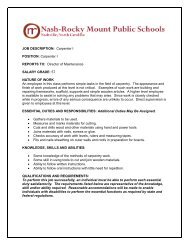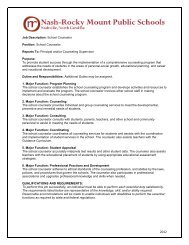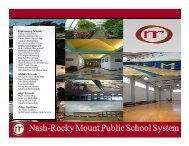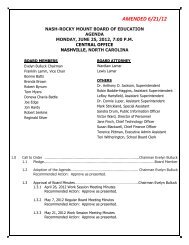2013-14 Student/Parent Handbook - Nash-Rocky Mount Schools
2013-14 Student/Parent Handbook - Nash-Rocky Mount Schools
2013-14 Student/Parent Handbook - Nash-Rocky Mount Schools
Create successful ePaper yourself
Turn your PDF publications into a flip-book with our unique Google optimized e-Paper software.
SECLUSION & RESTRAINT Policy Code 4302-R<br />
The following rules will govern the use of seclusion and restraint by school personnel. As used in this regulation, “school<br />
personnel” means employees of the board and any persons working on school grounds or at a school function under a contract or<br />
written agreement with the public school system or for another agency to provide educational or related services to students.<br />
A. PHYSICAL RESTRAINT<br />
Physical restraint means the use of physical force to restrict the free movement of all or a part of a student’s body.<br />
Physical restraint will be considered to be a reasonable use of force when used in the following circumstances:<br />
1. as reasonably needed to obtain possession of weapons or other dangerous objects on the person or within the control of a<br />
student;<br />
2. as reasonably needed to maintain order or to prevent or break up a fight;<br />
3. as reasonably needed for self-defense;<br />
4. as reasonably needed to ensure the safety of any student, employee, volunteer, or other person present;<br />
5. as reasonably needed to teach a skill, to calm or comfort a student, or to prevent self-injurious behavior;<br />
6. as reasonably needed to escort a student safely from one area to another;<br />
7. if used as provided for in an IEP, Section 504, or behavior intervention plan; or<br />
8. as reasonably needed to prevent imminent destruction to school or another person’s property.<br />
Except as set forth above, physical restraint of students will not be considered a reasonable use of force, and its use is prohibited.<br />
In addition, physical restraint will not be considered a reasonable use of force when used solely as a disciplinary consequence.<br />
B. MECHANICAL RESTRAINT<br />
Mechanical restraint means the use of any device or material attached or adjacent to a student’s body that restricts freedom of<br />
movement or normal access to any portion of the student’s body and that the student cannot easily remove.<br />
Mechanical restraint of a student by school personnel is permissible only in the following circumstances:<br />
1. when properly used as an assistive technology device included in the student’s IEP, Section 504, or behavior intervention<br />
2. plan or as otherwise prescribed by a medical or related service provider;<br />
2. when using seat belts or other safety restraints to secure a student during transportation;<br />
3. as reasonably needed to obtain possession of weapons or other dangerous objects on the person or within the control of a<br />
student;<br />
4. as reasonably needed for self-defense;<br />
5. as reasonably needed to ensure the safety of any student, employee, volunteer, or other person.<br />
Except as set forth above, mechanical restraint, including the tying down, taping, or strapping down of a student, will not be<br />
considered to be a reasonable use of force, and its use is prohibited.<br />
C. SECLUSION<br />
Seclusion means the confinement of a student alone in an enclosed space from which the student is (a) physically<br />
prevented from leaving or (b) incapable of leaving due to physical or intellectual capacity.<br />
Seclusion of a student by school personnel may be used in the following circumstances:<br />
1. as reasonably needed to respond to a person in control of a weapon or other dangerous object;<br />
2. as reasonably needed to maintain order or prevent or break up a fight;<br />
3. as reasonably needed for self-defense;<br />
4. as reasonably needed when a student’s behavior poses a threat of imminent physical harm to self or others or imminent<br />
substantial destruction of school or another person’s property; or<br />
5. when used as specified in the student’s IEP, Section 504, or behavior intervention plan; and<br />
a. the student is constantly monitored by an adult in close proximity who is able to see and hear the student at all times;<br />
b. the student is released from seclusion upon cessation of the behaviors that led to the seclusion or as<br />
otherwise specified in the student’s IEP, Section 504, or behavior intervention plan;<br />
c. the confining space has been approved for such use by the local education agency;<br />
d. the space is appropriately lighted, ventilated, and heated or cooled; and<br />
e. the space is free from objects that unreasonably expose the student or others to harm.<br />
Except as set forth above, the use of seclusion is not considered to be reasonable force, and its use is prohibited. In addition,<br />
seclusion will not be considered a reasonable use of force when used solely as a disciplinary consequence.<br />
19



